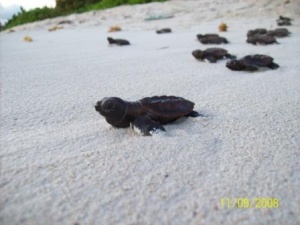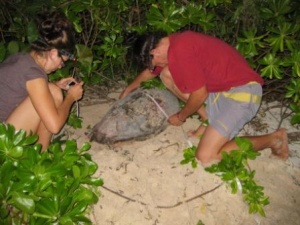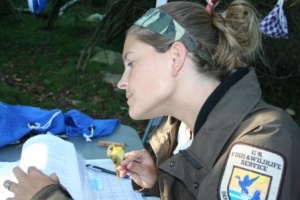Difference between revisions of "EEB BS/MS graduates"
ChrisElphick (Talk | contribs) (→'''Dan Brittan: Photovoltaic Systems Designer, Sunlight Solar Energy''') |
ChrisElphick (Talk | contribs) |
||
| Line 30: | Line 30: | ||
Since graduating from the BS/MS program in 2004, I have worked for several organizations including UCONN, the CT Department of Environmental Protection, and the US Department of Agriculture. My job responsibilities have ranged from writing a conservation plan for one of Audubon Connecticut’s Important Bird Areas, to radiotracking American Woodcock, to testing birds for Avian Influenza and West Nile Virus. I currently work as a biological science technician for US Fish and Wildlife in Charlestown, Rhode Island, where we own and manage five refuges. I am currently helping the refuge biologist write our annual work plan and long-term habitat management plan. I also help implement and conduct our biological inventory and monitoring program, which helps guide us in our habitat restoration and management decisions. I conduct various wildlife surveys (waterfowl, breeding bird, amphibian, etc.), run a fall bird banding station, and collect data on saltmarsh sparrows. Fieldwork may change from year to year depending on current projects that we may be involved with and/or funding availability. For more information on USFWS please see our website: http://www.fws.gov/. | Since graduating from the BS/MS program in 2004, I have worked for several organizations including UCONN, the CT Department of Environmental Protection, and the US Department of Agriculture. My job responsibilities have ranged from writing a conservation plan for one of Audubon Connecticut’s Important Bird Areas, to radiotracking American Woodcock, to testing birds for Avian Influenza and West Nile Virus. I currently work as a biological science technician for US Fish and Wildlife in Charlestown, Rhode Island, where we own and manage five refuges. I am currently helping the refuge biologist write our annual work plan and long-term habitat management plan. I also help implement and conduct our biological inventory and monitoring program, which helps guide us in our habitat restoration and management decisions. I conduct various wildlife surveys (waterfowl, breeding bird, amphibian, etc.), run a fall bird banding station, and collect data on saltmarsh sparrows. Fieldwork may change from year to year depending on current projects that we may be involved with and/or funding availability. For more information on USFWS please see our website: http://www.fws.gov/. | ||
| + | |||
| + | [[Category:Graduate Student Resources]] | ||
Revision as of 14:49, 19 February 2009
This page provides information on the positions that students from the BS/MS program have taken after finishing their degrees. The list in not exhaustive and some people may have moved on to other things, but it is designed to give current and prospective students a taste of where they could end up.
Contents
Kathryn Levasseur: Field co-director for the Jumby Bay Hawksbill Project
The Jumby Bay Hawksbill Project seeks to better understand the life history of the hawksbill, a critically endangered sea turtle, in order to serve as a foundation for wise management and policy making. The project is a collaboration between WIDECAST (The Wider Caribbean Sea Turtle Conservation Network, a partner organization to the United Nations Caribbean Environment Programme) and the Jumby Bay Island Company (an association of homeowners on Long Island, Antigua).
The importance of a research project such as the JBHP lies with its intensive monitoring and documentation of nesting activity through saturation tagging. Hourly beach patrols are done every night for six months (June-November) to ensure every nesting hawksbill is identified and documented. This rigorous data collection has continued since the project's inception in 1987. As an endangered species with a long generation time, hawksbills require long-term, consistent data to understand their population dynamics. Two decades of monitoring on Jumby Bay have now begun to shown a clear increase in the population (Richardson et al. 2006). The project also promotes public awareness of sea turtles regionally and internationally through local school visits and educational turtle watches for local residents, tourists, and members of the environmental division in Antigua. As field co-director, I am in charge of community outreach in addition to hourly beach patrols and data collection: tagging, measuring, photographing, egg counts, carapace mapping, nest excavations, etc.
Richardson, J. I., D. B. Hall, P. A. Mason, K. M. Andrews, R. Bjorkland, Y. Cai & R. Bell (2006) Eighteen years of saturation tagging data reveal a significant increase in nesting hawksbill sea turtles (Eretmochelys imbricata) on Long Island, Antigua. Animal Conservation 9: 302-307.
Chris Field: Important Bird Areas Coordinator, Audubon Connecticut
My first full-time job after graduation was coordinating research for an epidemiology lab at Yale. Currently, I work as Audubon's Important Bird Areas (IBA) Program Coordinator for Connecticut. My main responsibility is coordinating state-wide and site-based conservation planning for Connecticut's IBAs. For more information see: http://ct.audubon.org/IBAs.html.
Dan Britton: Photovoltaic Systems Designer, Sunlight Solar Energy
My current job title is Photovoltaic Systems Designer at Sunlight Solar Energy (http://www.sunlightsolar.com). In a nutshell, I visit potential sites for solar electricity and determine if the site is viable for solar, and if so, design a system that meets the energy needs and physical constraints of the building. I also spend a lot of time educating people, explaining how grid-tied solar system work, the various government incentives, and outlining the economics of solar.
Erin King: Biological Science Technician, USFWS
Since graduating from the BS/MS program in 2004, I have worked for several organizations including UCONN, the CT Department of Environmental Protection, and the US Department of Agriculture. My job responsibilities have ranged from writing a conservation plan for one of Audubon Connecticut’s Important Bird Areas, to radiotracking American Woodcock, to testing birds for Avian Influenza and West Nile Virus. I currently work as a biological science technician for US Fish and Wildlife in Charlestown, Rhode Island, where we own and manage five refuges. I am currently helping the refuge biologist write our annual work plan and long-term habitat management plan. I also help implement and conduct our biological inventory and monitoring program, which helps guide us in our habitat restoration and management decisions. I conduct various wildlife surveys (waterfowl, breeding bird, amphibian, etc.), run a fall bird banding station, and collect data on saltmarsh sparrows. Fieldwork may change from year to year depending on current projects that we may be involved with and/or funding availability. For more information on USFWS please see our website: http://www.fws.gov/.



